Page 110 of 386
Downloaded from www.Manualslib.com manuals search engine POWER WTNDOWS
The controls are near each window. Here’s how the master control works.
Express Down Window (Driver’s Side)
n
Just press the switch once -- for half a second or more -- and then let go. 4
The window will go all the way down. If you want to stop the window as it
is going down, press the switch again.
Your vehicle has Retained Accessory Power
(RAP). When you stop your
vehicle and turn the ignition key to “OFF”, you can still use your power
windows. The electrical power to the power windows will not shut off
until you open a door or
10 minutes has passed. If you want this power
for another
10 minutes, just turn the key to “RUN’’ and then back to
“OFF”.
pi-
Page 111 of 386
Downloaded from www.Manualslib.com manuals search engine ~ Rear Window Lock Out
HORN
With
this feature you
can cut electrical
power to the rear
power windows
by
pressing the right end
of the lock out switch.
This feature is useful
when you’re transporting small
children and you don’t
want them using the
power windows.
To sound the horn, just press the steering wheel pad.
THE TURN SIGNAEIMULTIFUNCTION
LEVER
97
,
i
Page 124 of 386
Downloaded from www.Manualslib.com manuals search engine Twilight Sentinel
Your Cadillac has this, the control is behind the headlight knob.
1
It switches your lights on and off by sensing how dark it is outside.
‘1
-.
r 1
U
To operate it, leave the light switch off and move the Twilight Sentinel
control to any position but
“OFE”
-
I
If you move the control all the way to MAX, your lights will stay on about
3 minutes after you turn off your engine. If you move the control almost
all the way in the other direction,
so it’s just on, the lights will go off
quickly when you turn off your engine.
Retained Accessory Power
When you stop your Cadillac and turn the ignition to OFF, you can use
these accessories for
10 more minutes.
Radio
Power windows
Astro roof
Windshield wipers
Trunk release
When
you open a door, everything will go off. And, after 10 minutes
everything will go
off also.
If
you want power for another 10 minutes, just turn the key to RUN and
back to
OFF.
-1
Page 152 of 386
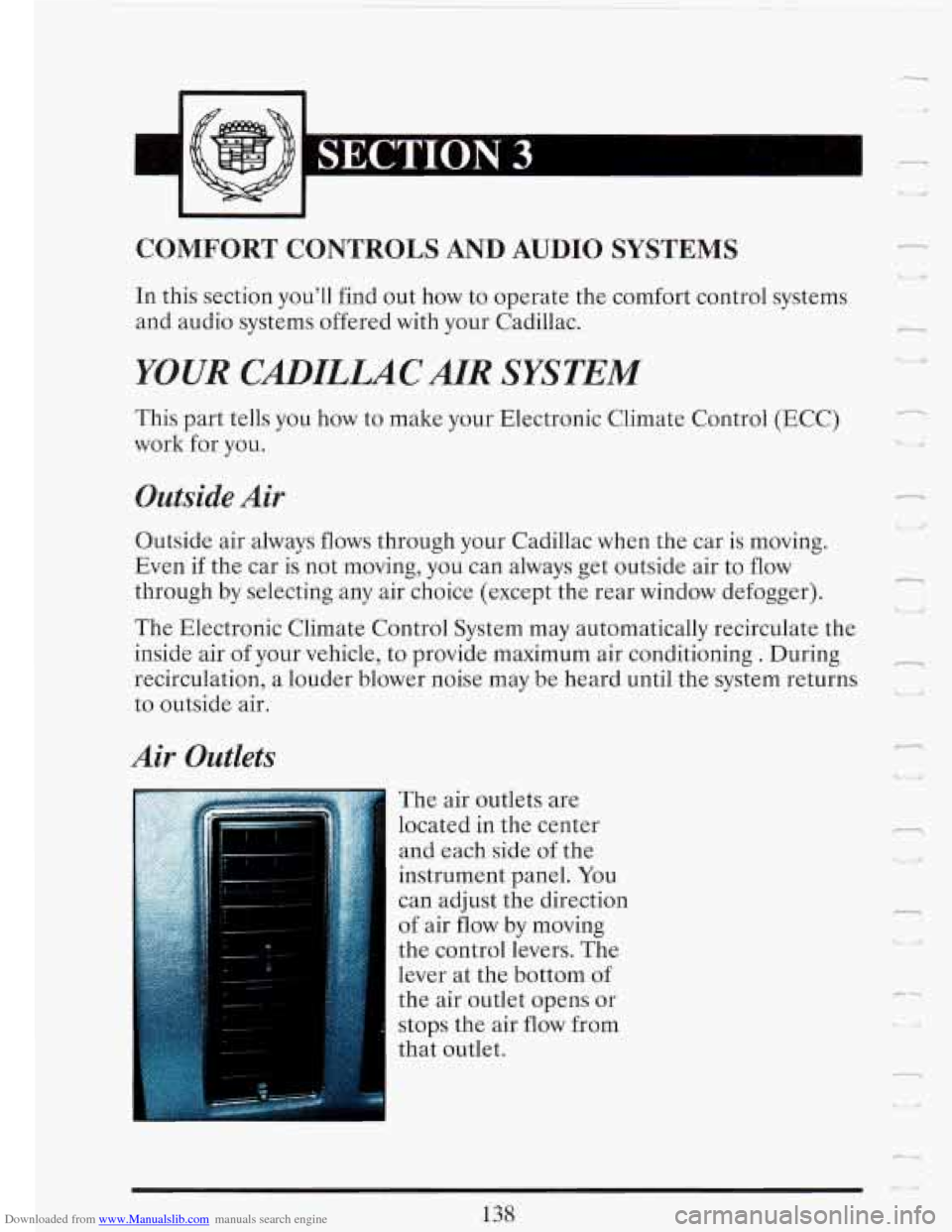
Downloaded from www.Manualslib.com manuals search engine I n
COMFORT CONTROLS AND AUDIO SYSTEMS
In this section you'll find out how to operate the comfort control systems
and audio systems offered with your Cadillac.
YOUR CIILLACMR SYSTEM
This part tells you how to make your Electronic Climate Control (ECC)
work for you.
Outside Air
Outside air always flows through your Cadillac when the car is moving.
Even if the car is not moving, you can always get outside air to flow
through by selecting.any air choice (except the rear window defogger).
n '< u1
The Electronic Climate Control System may automatically recirculate the
inside air
of your vehicle, to provide maximum air conditioning . During
recirculation, a louder blower noise may be heard until the system returns
to outside air.
_.
Air Outlets tl
L t I'
The air outlets are
located in the center
and each side of the
instrument panel. You
can adjust the direction
of air flow by moving
the control levers. The
lever at the bottom
of
the air outlet opens or
stops the air flow from
that outlet.
n
14
1
U
138
Page 156 of 386
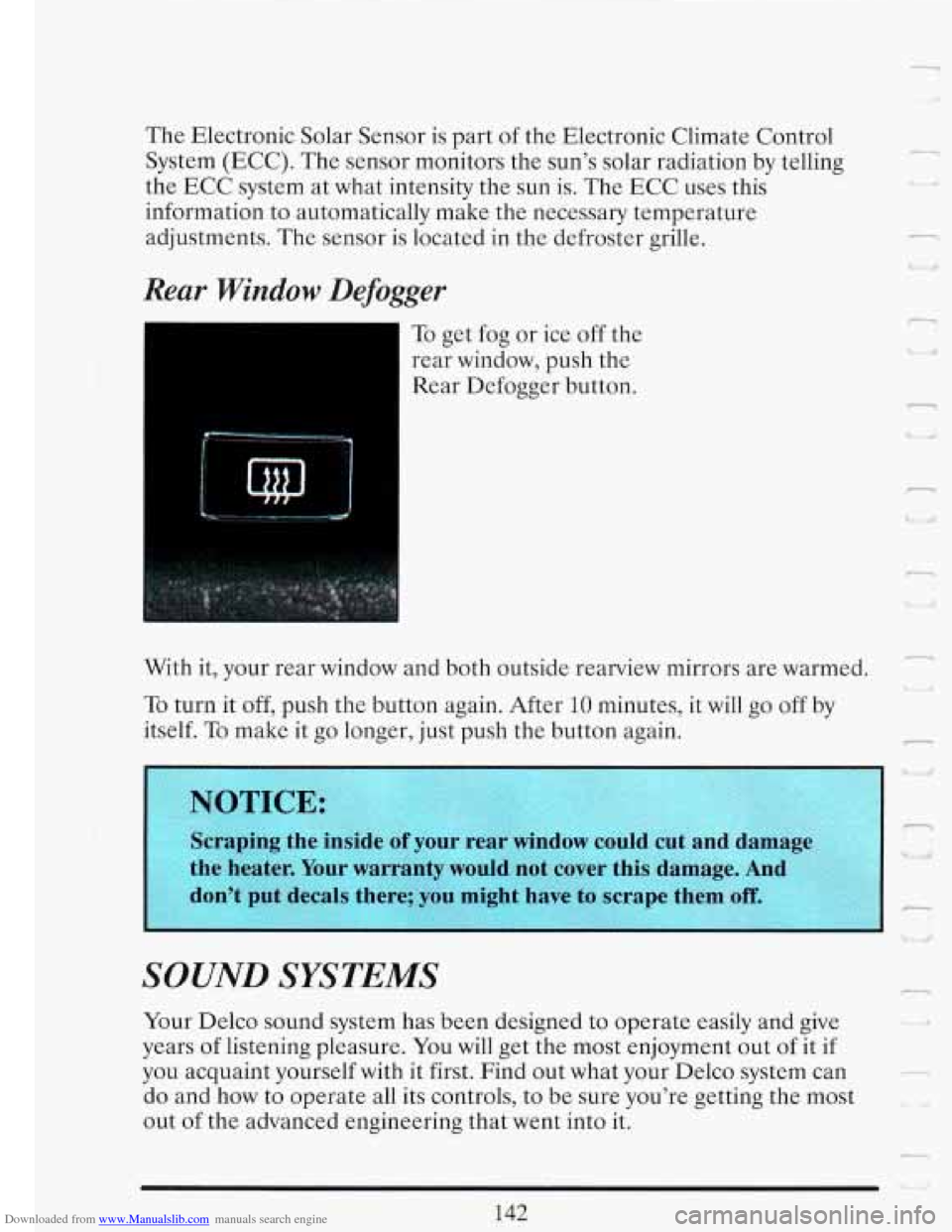
Downloaded from www.Manualslib.com manuals search engine The Electronic Solar Sensor is part of the Electronic Climate Control
System (ECC). The sensor monitors the
sun’s solar radiation by telling
the
ECC system at what intensity the sun is. The ECC uses this
information to automatically make the necessary temperature
adjustments. The sensor is located in the defroster grille.
Rear Window Defogger
To get fog or ice off the
rear window, push the
Rear Defogger button.
With it, your rear window and both outside rearview mirrors are warmed.
To turn it off, push the button again. After
10 minutes, it will go off by
itself. To make it go longer, just push the button again.
n
n .-
-I
SOUND SYSTEMS
Your Delco sound system has been designed to operate easily and give
years of listening pleasure.
You will get the most enjoyment out of it if
you acquaint yourself with it first. Find out what your Delco system can
7.
do and how to operate all its controls, to be sure you’re getting the most - i
out of the advanced engineering that went into it.
1 t d
142
Page 179 of 386
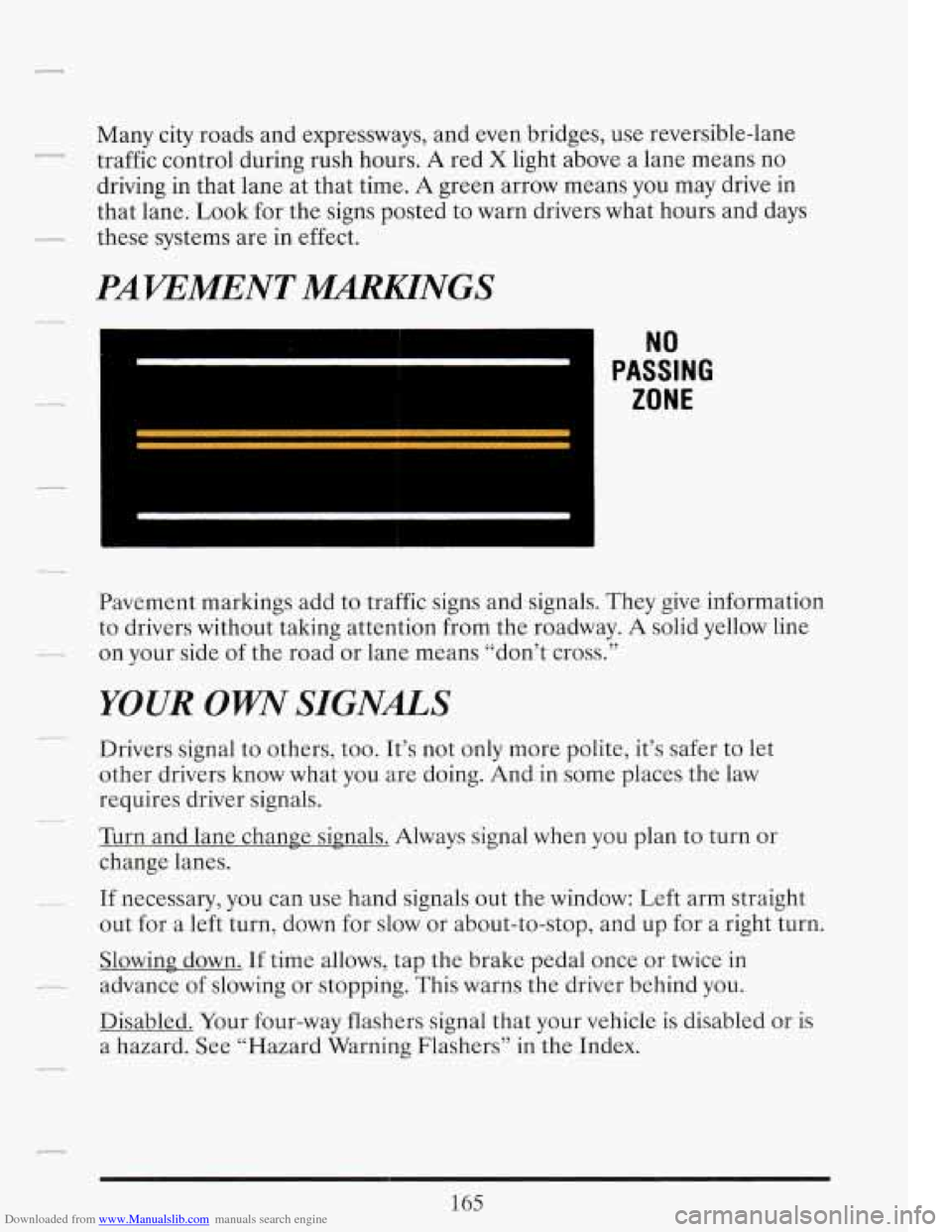
Downloaded from www.Manualslib.com manuals search engine Many city roads and expressways, and even bridges, use reversible-lane
traffic control during rush hours.
A red X light above a lane means no
driving in that lane at that time.
A green arrow means you may drive in
that lane.
Look for the signs posted to warn drivers what hours and days
these systems are in effect.
Pavement markings add
to traffic signs and signals. They give information
to drivers without taking attention from the roadway.
A solid yellow line
on your side of the road or lane means “don’t cross.’’
YOUR OWW SIGNALS
Drivers signal to others, too. It’s not only more polite, it’s safer to let
other drivers know what you are doing. And in some places the law
requires driver signals.
Turn and lane change signals. Always signal when you plan to turn or
change lanes.
If necessary, you can use hand signals out the window: Left arm straight
out for a left turn, down for slow or about-to-stop, and up for a right turn.
Slowing down. If time allows, tap the brake pedal once or twice in
advance of slowing or stopping. This warns the driver behind
you.
Disabled. Your four-way flashers signal that your vehicle is disabled or is
a hazard. See “Hazard Warning Flashers” in the Index.
165
Page 210 of 386
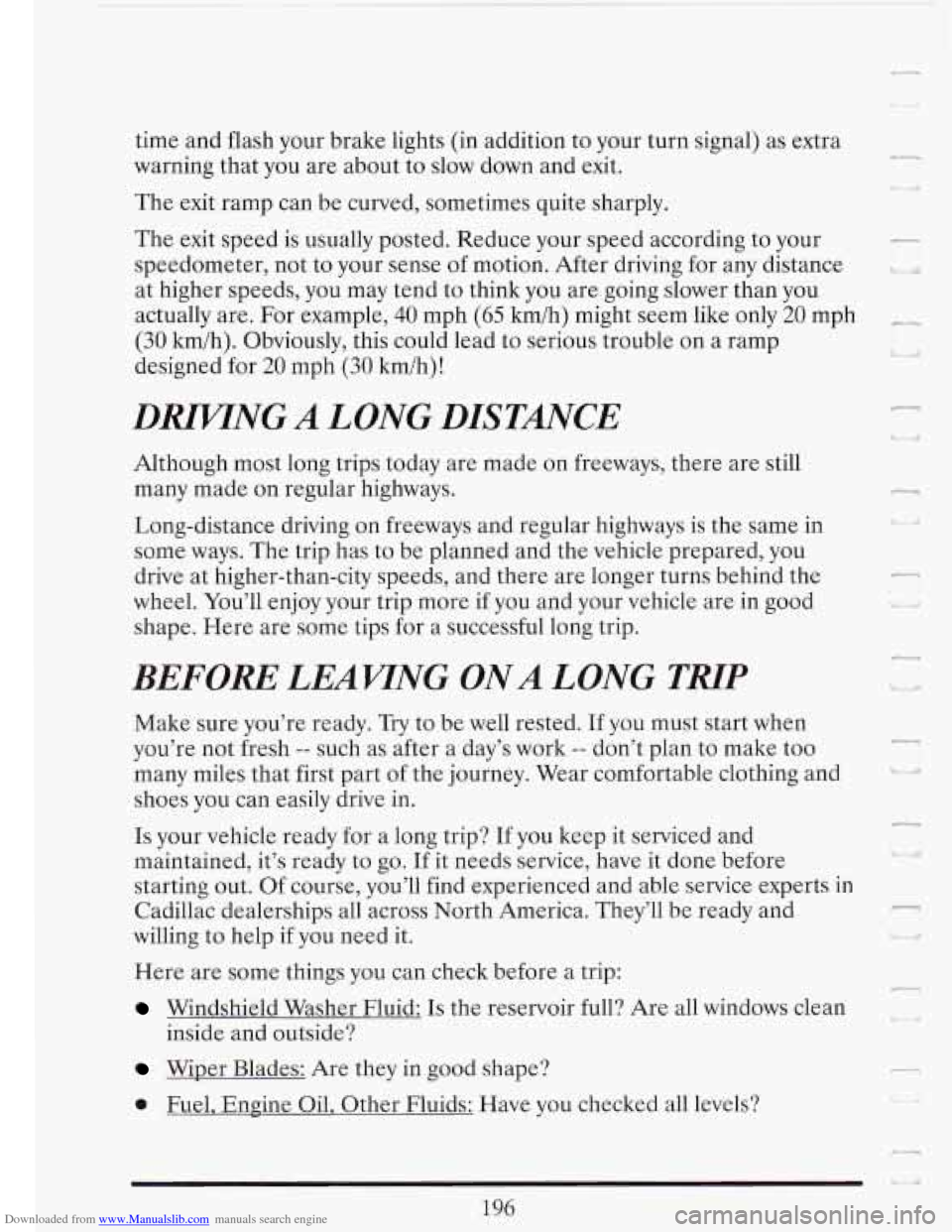
Downloaded from www.Manualslib.com manuals search engine time and flash your brake lights (in addition to your turn signal) as extra
warning that you are about to slow down and exit.
The exit ramp can be curved, sometimes quite sharply.
-.
U t I! The exit speed is usually posted. Reduce your speed according to your
speedometer, not to your sense
of motion. After driving for any distance
at higher speeds, you may tend to think you are going slower than you
actually are. For example,
40 mph (65 h/h) might seem like only 20 mph c_?
(30 km/h). Obviously, this could lead to serious trouble on a ramp
designed for
20 mph (30 kmih)!
I
L/
DRIVTNG A LONG DISTANCE
Although most long trips today are made on freeways, there are still
many made on regular highways.
Long-distance driving on freeways and regular highways is the same in
some ways. The trip has
to be planned and the vehicle prepared, you
drive at higher-than-city speeds, and there are longer turns behind the
wheel. You’ll enjoy your trip more if you and your vehicle are in good
shape. Here are some tips for a successful long trip.
BEFORE LEAWNG ONA LONG TRlP
Make sure you’re ready. Try to be well rested. If you must start when
you’re not fresh
-- such as after a day’s work -- don’t plan to make too
many miles that first part of the journey. Wear comfortable clothing and
shoes you can easily drive in.
.3
I
F i ! u
Is your vehicle ready for a long trip? If you keep it serviced and
maintained, it’s ready to
go. If it needs service, have it done before
starting out. Of course, you’ll find experienced and able service experts in
Cadillac dealerships all across North America. They’ll be ready and
7
willing to help if you need it. -1
Here are some things you can check before a trip:
Windshield Washer Fluid: Is the reservoir full? Are all windows clean
inside and outside?
Wiper Blades: Are they in good shape?
0 Fuel, Engine Oil, Other Fluids: Have you checked all levels?
Page 221 of 386
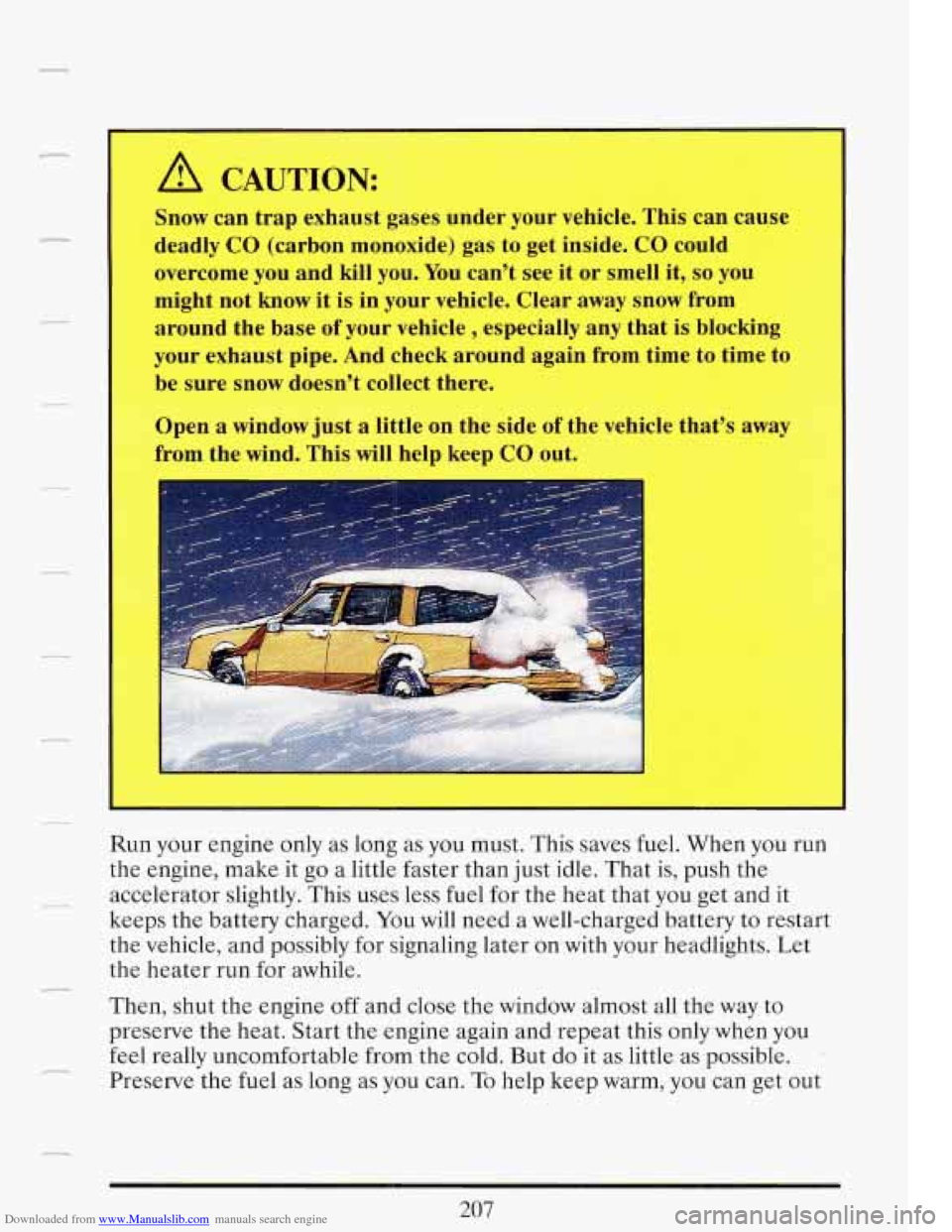
Downloaded from www.Manualslib.com manuals search engine A CAUTION:
Snow can trap exhaust gases under your vehicle. This can cause
deadly CO (carbon monoxide) gas to get inside. CO could
overcome you and kill you. You can’t see it or smell it,
so you
might not know it is in your vehicle. Clear away snow from
around the base
of your vehicle , especially any that is blocking
your exhaust pipe. And check around again from time to time to
be sure snow doesn’t collect there.
Open a window just a little on the side
of the vehicle that’s away
from the wind. This will help keep CO out.
Run your engine only as long as you must. This saves fuel. When you run
the engine, make it go a little faster than just idle. That is, push the
accelerator slightly. This uses less fuel for the heat that you get and it
keeps the battery charged. You
will need a well-charged battery to restart
the vehicle, and possibly for signaling later
on with your headlights. Let
the heater run for awhile.
207
Then, shut the engine off and close the window almost all the way to
preserve the heat. Start the engine again and repeat this only when you
feel really uncomfortable from the cold. But
do it as little as possible.
Preserve the fuel as long as you can. To help keep warm, you can get out